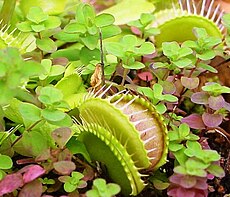Droseraceae
| Droseraceae Temporal range: Late Cretaceous – Recent |
|
|---|---|
 |
|
| Venus flytrap (Dionaea muscipula) | |
| Scientific classification | |
| Kingdom: | Plantae |
| (unranked): | Angiosperms |
| (unranked): | Eudicots |
| (unranked): | Core eudicots |
| Order: | Caryophyllales |
| Family: |
Droseraceae Salisb. |
| Genera | |
|
Aldrovanda |
|
Aldrovanda
Dionaea
Drosera
†?Droserapollis
†?Droserapites
†?Droseridites
†?Fischeripollis
†?Palaeoaldrovanda
†?Saxonipollis
Droseraceae is a family of flowering plants. The family is also known as the sundew family. It is a small family of carnivorous plants, which consist of approximately 180 species in three extant genera:
Most of the members of Droseraceae are contained in Drosera, the true sundews. Both Dionaea and Aldrovanda have only one extant species. Droseras secrete a sticky substance from their leaves that traps prey. Dionaea and Aldrovanda both use snap-traps that close rapidly when the leaves are disturbed, Dionaea is terrestrial, while Aldrovanda is strictly aquatic. Like carnivorous plants of other families, the Droseraceae are able to supplement their nutrient intake, especially that of nitrogen, by capturing and digesting small animals such as insects. In this way, these plants are able to thrive in nutrient-deficient areas, such as sphagnum bogs.
Drosera is one of the largest genera of carnivorous plants, and individual species vary extensively in their specific morphology. Common to all members of Drosera are highly modified leaves lined with tentacle-like glandular trichomes. At the end of each trichome, a bead of highly viscous mucilage is secreted, which resembles a drop of dew. The mucilage is a fairly pure aqueous solution of acidic polysaccharides with high molecular weights, which makes the mucilage not only highly viscous, but also very sticky, so much so, a single drop of mucilage may be stretched to lengths of up to a meter and cover one million times its original surface area. Insects and other prey animals are attracted by the smell of this mucilage and become stuck in it. Such snares are termed “flypaper traps”, but the trapping mechanism of sundews is often erroneously described as “passive”. In fact, sundew traps are quite active and sensitive, and the disturbance of one or a few trichomes quickly triggers an action potential that stimulates the rapid movement of other trichomes toward the prey. The leaf then curls in on itself, enveloping the prey for digestion.
...
Wikipedia
